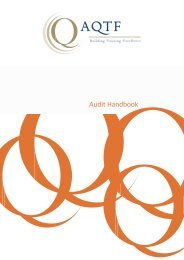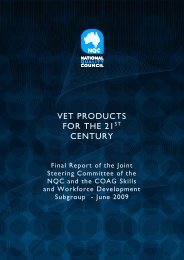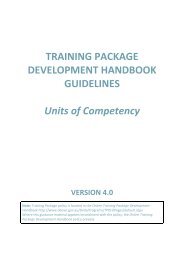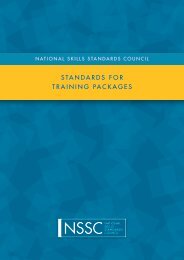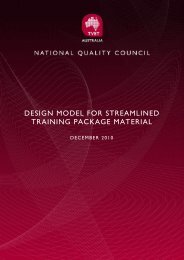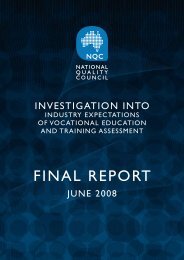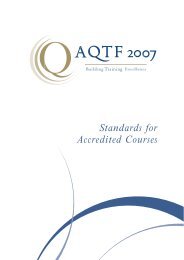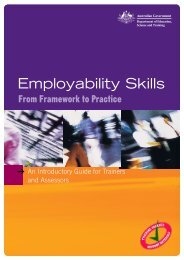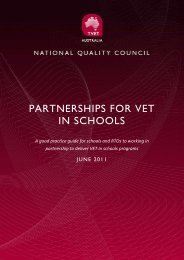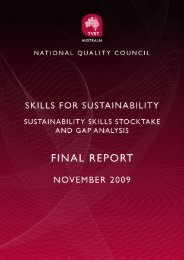training packages glossary of terms - National Skills Standards ...
training packages glossary of terms - National Skills Standards ...
training packages glossary of terms - National Skills Standards ...
Create successful ePaper yourself
Turn your PDF publications into a flip-book with our unique Google optimized e-Paper software.
GlossaryAccess and Equity: policies and approaches aimed at ensuring that vocational education and<strong>training</strong> (VET) are responsive to the individual needs <strong>of</strong> clients whose age, gender, cultural orethnic background, disability, sexuality, language skills, literacy or numeracy level,unemployment, imprisonment or remote location may present a barrier to access,participation and the achievement <strong>of</strong> suitable outcomes. Access and equity do not mean that aRegistered Training Organisation (RTO) has to accept anyone as a client.Action Learning: a group‐based learning model in which the participants contribute theirknowledge and expertise to guide the learning experience.Advanced Diploma: a qualification in the vocational education and <strong>training</strong> (VET) and highereducation sectors which recognises skills and knowledge meeting national competencystandards (or competencies consistent with these levels where the national industrycompetency standards are not applicable). The Advanced Diploma is a more specialisedqualification and signifies skill and knowledge <strong>of</strong> a greater complexity and a higher level <strong>of</strong>personal accountability than is required at a Diploma level.Application <strong>of</strong> the Unit: a brief description <strong>of</strong> how the unit is practically applied in industry.Apprenticeship/Traineeship: a structured <strong>training</strong> arrangement for a person employed underan apprenticeship/traineeship <strong>training</strong> contract. It usually involves the person receiving<strong>training</strong> and being assessed both on and <strong>of</strong>f the job.Apprenticeship/Traineeship Training Contract: a contract governing the <strong>terms</strong> <strong>of</strong> anapprenticeship or traineeship that is made between an employer and a person employed bythem as an apprentice or trainee. The contract must be registered with the relevant state orterritory's government department or agency in accordance with that state's or territory'slegislation. The <strong>training</strong> provided under the contract must be delivered by a RegisteredTraining Organisation (RTO) approved by the state or territory's department or agency and a<strong>training</strong> plan developed by the RTO must form the basis <strong>of</strong> the person's <strong>training</strong> andassessment.Articulation: a process that enables students to progress from one completed qualification toanother with credit in a defined pathway.Assessment: the process <strong>of</strong> collecting evidence and making judgements on whethercompetency has been achieved, to confirm that an individual can perform to the standardexpected in the workplace, as expressed by the relevant endorsed industry/enterprisecompetency standards <strong>of</strong> a Training Package or by the learning outcomes <strong>of</strong> an accreditedcourse.1V2.1 170310
Assessment Context: the environment in which the assessment <strong>of</strong> competency will becarried out. This may be the environment where the work is performed 'in situ', a simulatedenvironment which replicates the work environment, various contexts which address differentaspects <strong>of</strong> the competency. It also includes physical and operational factors, the assessmentsystem within which assessment is carried out, the range <strong>of</strong> opportunities for gatheringevidence in a number <strong>of</strong> situations, the purpose <strong>of</strong> the assessment, who carries out theassessment and the period <strong>of</strong> time during which the assessment takes place.Assessment Guidelines: the endorsed component <strong>of</strong> a Training Package that underpinsassessment and sets out the industry's approach to valid, reliable, flexible and fair assessment.Assessment Judgement: the exercise <strong>of</strong> thinking skills by the assessor to evaluate whether theevidence provided meets the principles <strong>of</strong> assessment and rules <strong>of</strong> evidence and whether thecandidate is competent or not yet competent based on the evaluated evidence.Assessment Methods: the particular technique/s used to gather different types <strong>of</strong> evidence.This may include methods or techniques such as questioning, direct observation, structuredactivities, third party feedback, portfolios and review <strong>of</strong> products.Assessment Only Pathway: the achievement <strong>of</strong> competencies or qualifications recognisedthrough a process <strong>of</strong> formal assessment by an assessor which involves evaluative judgement <strong>of</strong>collected evidence arising from any combination <strong>of</strong> formal or informal education and <strong>training</strong>and education, work experience and/or general life experience; recognition <strong>of</strong> competenceheld through a process <strong>of</strong> assessment that is not directly linked to a structured learningprocess to support achievement <strong>of</strong> the competencies.Assessing risk in assessment: concerned with gauging the likelihood <strong>of</strong> unexpected and/orunfortunate consequences. For example, determining the level <strong>of</strong> risk (e.g., in <strong>terms</strong> <strong>of</strong> safety,costs, equity etc) <strong>of</strong> assessing someone as competent when in actual fact they are notcompetent, and or vice versa.Assessment quality management: processes that could be used to help achieve comparability<strong>of</strong> standards. Typically, there are three major components to quality management <strong>of</strong>assessments: quality assurance, quality control and quality review.Assessment Strategy: a documented framework to guide and structure assessmentarrangements for a vocational education and <strong>training</strong> (VET) qualification.See also: Learning Strategy and Training and Assessment Strategy2V2.1 170310
Assessment System: a controlled and ordered process designed to ensure that assessmentdecisions made in relation to many individuals, by many assessors, in many situations areconsistent, fair, valid and reliable, and may include: grievances and appeals process, validationsystems and processes, reporting/recording arrangements, acquisition <strong>of</strong> physical and humanresources, administrative procedures, roles and responsibilities, partnership arrangements,quality assurance mechanisms, risk management strategies, and documented assessmentprocesses.Assessment Tool: an assessment tool includes the following components: the context andconditions for the assessment, the tasks to be administered to the candidate, an outline <strong>of</strong> theevidence to be gathered from the candidate and the evidence criteria used to judge the quality<strong>of</strong> performance (i.e. the assessment decision making rules). It also includes the administration,recording and reporting requirements.Assessor: An assessor means an individual or organisation responsible for the assessment <strong>of</strong>Units <strong>of</strong> Competency in accordance with the Australian Quality Training Framework.Australian Apprenticeships: a job pathway that combines <strong>training</strong> for a nationally recognisedqualification with employment. The term Australian Apprenticeships covers bothApprenticeships and Traineeships.Australian Qualifications Framework (AQF): the policy framework that defines allqualifications recognised nationally in post‐compulsory education and <strong>training</strong> in Australia. TheAQF comprises titles and guidelines that define each qualification, as well as the principles andprotocols covering cross‐sectoral qualification links and the issuing <strong>of</strong> qualifications andstatements <strong>of</strong> attainment.Australian Qualifications Framework Alignment: alignment to the Australian QualificationsFramework (AQF) occurs when a group <strong>of</strong> units <strong>of</strong> competency are a viable AQF qualification orqualifications (in line with the guidance provided in the current AQF ImplementationHandbook).Australian Quality Training Framework (AQTF): the Australian Quality Training Framework(AQTF) is a set <strong>of</strong> nationally agreed quality assurance arrangements for <strong>training</strong> andassessment services delivered by <strong>training</strong> organisations. The first version <strong>of</strong> AQTF wasimplemented in 2002. It was revised in 2005 and again in 2007 including the identification <strong>of</strong>excellence criteria.The AQTF comprises:a) AQTF 2007 Essential <strong>Standards</strong> for Registrationb) AQTF 2007 <strong>Standards</strong> for State and Territory Registering Bodiesc) AQTF 2007 Excellence Criteriad) AQTF 2007 <strong>Standards</strong> for Accredited Coursese) AQTF 2007 <strong>Standards</strong> for State and Territory Course Accrediting Bodies.3V2.1 170310
Authenticity: one <strong>of</strong> the rules <strong>of</strong> evidence. To accept evidence as authentic, an assessor mustbe assured that the evidence presented for assessment is the candidate's own work.Award: see QualificationBenchmarking assessment: benchmarks are a point <strong>of</strong> reference used to clarify standards inassessment. They are agreed good examples <strong>of</strong> particular levels <strong>of</strong> achievement which arisefrom the moderation process. Benchmarks help clarify the standards expected within thequalification, and illustrate how they can be demonstrated and assessed. They can also identifynew ways <strong>of</strong> demonstrating the competency.Case for Endorsement: provides compelling evidence <strong>of</strong> the quality, industry relevance andstakeholder support for the new units <strong>of</strong> competency, Skill Sets (if applicable), qualifications orTraining Package. The Case for Endorsement is compiled by the Industry <strong>Skills</strong> Council (ISC) foreach submission and is the basis on which <strong>National</strong> Quality Council (NQC) members will maketheir endorsement decision.Categories <strong>of</strong> Change: see ISC Upgrade and NQC Endorsement RequiredCertificate I‐IV: a set <strong>of</strong> qualifications that prepare candidates for both employment andfurther education and <strong>training</strong>. These qualifications recognise achievement <strong>of</strong> specifiednational industry competency standards at four Australian Qualifications Framework (AQF)levels in a wide variety <strong>of</strong> trades, industries and enterprises. These qualifications may begained through a wide range <strong>of</strong> pathways, including: Australian Apprenticeships (includingTraineeships); work‐based and/or school/institution‐based <strong>training</strong>; and Recognition <strong>of</strong> PriorLearning (RPL) (which may include <strong>training</strong> programs or an accumulation <strong>of</strong> short courses).Clustering: the process <strong>of</strong> grouping competencies into combinations which have meaning andpurpose for learning, assessment, or work related needs.Code: the unique alpha‐numeric identifier allocated to the endorsed components <strong>of</strong> a TrainingPackage.See also: Qualification Code, Training Package Code and Unit <strong>of</strong> Competency CodeComparability <strong>of</strong> standards: comparability <strong>of</strong> standards are said to be achieved when theperformance levels expected (e.g., competent/not yet competent decisions) for a unit (orcluster <strong>of</strong> units) <strong>of</strong> competency are similar between assessors assessing the same unit(s) in agiven RTO and between assessors assessing the same unit(s) across RTOs.Competency: Competency is the consistent application <strong>of</strong> knowledge and skill to the standard<strong>of</strong> performance required in the workplace. It embodies the ability to transfer and apply skillsand knowledge to new situations and environments.4V2.1 170310
Competency based assessment: competency based assessment is a purposeful process <strong>of</strong>systematically gathering, interpreting, recording and communicating to stakeholders,information on candidate development against industry competency standards and/orlearning outcomes.Competency Field: denotes the industry sector, specialisation or function, or the way the units<strong>of</strong> competency are categorised in the Training Package.Competency Standard: see Unit <strong>of</strong> CompetencyConsistency <strong>of</strong> evidence: the evidence gathered needs to be evaluated for its consistency withother assessments <strong>of</strong> the candidate’s performance, including the candidate’s usualperformance levels.Construct validity: the extent to which certain explanatory concepts or constructs account forthe performance on a task. It is concerned with the degree to which the evidence collected canbe used to infer competence in the intended area, without being influenced by other nonrelatedfactors (e.g. literacy levels).Content validity: the match between the required knowledge and skills specified in thecompetency standards and the assessment tool’s capacity to collect such evidence.Contextualisation <strong>of</strong> a qualification: refers to the substitution <strong>of</strong> unit/s <strong>of</strong> competency in aqualification for unit/s from other qualification/s in the same Training Package or from otherendorsed Training Packages to maximise its application in industry and/or to meet the needs<strong>of</strong> particular learners, within the confines <strong>of</strong> the packaging rules. Contextualisation <strong>of</strong>qualifications must not distort the qualification purpose or its alignment with the AustralianQualifications Framework (AQF). The substitution must be consistent with the relevantTraining Package advice on allowable contextualisation <strong>of</strong> qualifications and consistent withthe Training Package Development Handbook.Contextualisation <strong>of</strong> a unit <strong>of</strong> competency: refers to the addition <strong>of</strong> industry orenterprise/organisation specific information to the range statement and/or evidence guide <strong>of</strong>a unit <strong>of</strong> competency to maximise its application to particular enterprise/organisationcontexts. Training Package developers can contextualise units imported from other Packagesfor their specific industry requirements. Registered Training Organisations (RTOs) cancontextualise units <strong>of</strong> competency to make them more relevant and meaningful to learnersand enterprises. Such changes must not diminish the competency’s breadth, reduce itsportability, or limit its use. Changes are made in accordance with the Training PackageDevelopment Handbook and with relevant Training Package contextualisation guidelines.5V2.1 170310
Contingency Management <strong>Skills</strong>: one <strong>of</strong> the four dimensions <strong>of</strong> competency. These skillsinvolve the requirement to respond to irregularities and breakdowns in routine.Continuous Improvement: the process whereby Industry <strong>Skills</strong> Councils (ISCs) applycontinuous improvements to Training Packages during their endorsement period.Continuous Improvement Plan: details the changes to be made to the endorsed components<strong>of</strong> Training Packages to enable them to meet the emerging skill needs <strong>of</strong> industry. TheEnvironmental Scan informs the Continuous Improvement Plan. It is developed annually byeach Industry <strong>Skills</strong> Council (ISC) as a rolling three‐year plan.Credit: the value assigned for the recognition <strong>of</strong> equivalence in content and learningoutcomes between different types <strong>of</strong> learning and/or qualifications which reduces the amount<strong>of</strong> learning required to achieve a qualification.Credit Transfer: a process that provides students with agreed and consistent credit outcomesbased on identified equivalence in content and learning outcomes between matchedqualificationsCurrency: one <strong>of</strong> the rules <strong>of</strong> evidence. In assessment, currency relates to the age <strong>of</strong> theevidence presented by a candidate to demonstrate that they are still competent. Competencyrequires demonstration <strong>of</strong> current performance, so the evidence collected must be from eitherthe present or the very recent past.Customisation: See Contextualisation <strong>of</strong> a unit <strong>of</strong> competency and Contextualisation <strong>of</strong> aqualificationDecision making rules: the rules to be used to make judgements as to whether competencyhas been achieved (note that if grades or scores are also to be reported, the scoring rulesshould outline how performance is to be scored). Such rules should be specified for eachassessment tool. There should also be rules for synthesising multiple sources <strong>of</strong> evidence tomake overall judgements <strong>of</strong> performance.Delivery Method: the particular techniques used to guide, facilitate and support the learningprocess.Delivery Strategy: forms part <strong>of</strong> the learning strategy and involves developing anddocumenting: the focus <strong>of</strong> delivery, the context <strong>of</strong> delivery, the mode <strong>of</strong> delivery and deliverymethods.6V2.1 170310
Development and Endorsement Process: the process, agreed by the <strong>National</strong> Quality Council(NQC), for the development and endorsement <strong>of</strong> Training Packages that enablesresponsiveness to industry priorities for new and updated skills.Dimensions <strong>of</strong> Competency: dimensions are part <strong>of</strong> the broad concept <strong>of</strong> competency, whichincludes all aspects <strong>of</strong> work performance as represented by task skills, task management skills,contingency management skills and job/role environment skills.See also: Contingency Management <strong>Skills</strong>, Job/Role Environment <strong>Skills</strong>, Task Management<strong>Skills</strong> and Task <strong>Skills</strong>Diploma: a qualification in the vocational education and <strong>training</strong> (VET) and higher educationsectors which recognises skills and knowledge meeting national competency standards (orcompetencies consistent with these levels where the national industry competency standardsare not applicable). The length <strong>of</strong> study varies according to the particular pathways andindustry involved, with full time study involving the equivalent <strong>of</strong> two years for a Diploma.Students can commence a Diploma directly or advance to a Diploma from a lower Certificatelevel.Direct Observation: an assessment method which involves opportunities to view realwork/real time activities in the workplace or work activities in a simulated workplaceenvironment.Editorial Report: a report confirming that the draft endorsed components <strong>of</strong> a TrainingPackage being submitted to the <strong>National</strong> Quality Council (NQC) have met the agreedrequirements for editing.Elements: elements <strong>of</strong> a unit <strong>of</strong> competency that describe actions or outcomes which aredemonstrable and assessable.See also: Performance CriteriaEmployability <strong>Skills</strong>: the non‐technical skills and competencies that have always been animportant part <strong>of</strong> effective and successful participation in the workplace. Employability skillsare applicable to all occupations, and have been defined in the vocational education and<strong>training</strong> (VET) sector as: communication, teamwork, problem solving, initiative and enterprise,planning and organising, self management, learning and technology.Employability <strong>Skills</strong> Summaries: the table in a Training Package that contains a summary <strong>of</strong>the Employability <strong>Skills</strong> as identified by industry or enterprise for this qualification and theeight employability skills with a summary <strong>of</strong> examples <strong>of</strong> contextualised employability skillsfacets.Endorsement: the formal recognition <strong>of</strong> Training Packages by the <strong>National</strong> Quality Council(NQC).7V2.1 170310
Endorsement Date: the date on which the <strong>National</strong> Quality Council (NQC) endorses theTraining Package content. The Endorsement Date is added to the Training Package on the<strong>National</strong> Training Information Service (NTIS) by the Department <strong>of</strong> Education, Employment andWorkplace Relations (DEEWR) prior to publication on NTIS.Entry Requirements: specified prior knowledge, skill, and experience, expressed in <strong>terms</strong> <strong>of</strong>competency, and may include licensing or industry recognised standards. Where entryrequirements are identified, these are mandatory. Entry requirements:• do not form part <strong>of</strong> a qualification for <strong>training</strong> and assessment purposes.• must be completed prior to enrolling in a qualification.• must be specific to the knowledge, skills or experience required to enter aqualification.Environmental Scan: a document developed on an annual basis by each Industry <strong>Skills</strong> Council(ISC) that captures and analyses the most recent grass‐roots industry intelligence gathered bythe ISC, identifying existing and emerging skill shortages and <strong>training</strong> requirements.Equity Report: a report confirming that the draft endorsed components in a Training Packagebeing submitted to the <strong>National</strong> Quality Council (NQC) have met the agreed requirements forequity.Evidence: information gathered to support a judgement <strong>of</strong> competence against thespecifications <strong>of</strong> the relevant unit or units <strong>of</strong> competency.Evidence Guide: provides essential advice for assessment <strong>of</strong> the unit <strong>of</strong> competency and mustbe read in conjunction with the elements, performance criteria and range statement <strong>of</strong> theunit <strong>of</strong> competency, and the Training Package Assessment Guidelines.Face validity: the extent to which the assessment tasks reflect real work‐based activities.Fairness: one <strong>of</strong> the principles <strong>of</strong> assessment. Fairness in assessment requires consideration <strong>of</strong>the individual candidate's needs and characteristics, and any reasonable adjustments thatneed to be applied to take account <strong>of</strong> them. It requires clear communication between theassessor and the candidate to ensure that the candidate is fully informed about, understandsand is able to participate in the assessment process, and agrees that the process isappropriate. It also includes an opportunity for the person being assessed to challenge theresult <strong>of</strong> the assessment and to be reassessed if necessary.Flexibility (assessment): one <strong>of</strong> the principles <strong>of</strong> assessment. To be flexible, assessmentshould: reflect the candidate's needs; provide for recognition <strong>of</strong> competencies no matter how,where or when they have been acquired; draw on a range <strong>of</strong> methods appropriate to thecontext, competency and the candidate; and support continuous competency development.8V2.1 170310
Flexibility (quality): one <strong>of</strong> the quality principles for Training Package development. Theendorsed components <strong>of</strong> a Training Package must provide the flexibility to meet the diversity<strong>of</strong> individual and enterprise needs, support equitable access and progression <strong>of</strong> learners, andsupport learner transition between education sectors.Formal Learning: learning that takes place through a structured program <strong>of</strong> learning andassessment that leads to the full or partial attainment <strong>of</strong> a recognised AQF qualification orother formally recognised qualification.Functionality: one <strong>of</strong> the quality principles for Training Package development. The endorsedcomponents <strong>of</strong> a Training Package must provide the functionality, through ease <strong>of</strong>understanding, clever design and consistency with policy and publication requirements, tosupport implementation across a range <strong>of</strong> settings, support sound assessment practice, andnot impose structural barriers to implementation.Impact Statement: details the implications <strong>of</strong> the new or revised units <strong>of</strong> competency, SkillSets, qualifications or Training Package, and the extent <strong>of</strong> change required to enable successfulimplementation in various delivery environments. It is compiled by the Industry <strong>Skills</strong> Council(ISC) for each Case for Endorsement based on information gathered throughout theconsultation process.Industry: includes, but is not limited to, business owners and employers and theirrepresentative bodies , employees and unions, and their representative bodies.Industry <strong>Skills</strong> Councils (ISCs): national bodies contracted by the Department <strong>of</strong> Education,Employment and Workplace Relations to develop and maintain Training Packages specific tothe industry area(s) for which they have coverage.Industry <strong>Skills</strong> Council Quality Assurance Panel: an expert resource for Industry <strong>Skills</strong> Councils(ISCs) on matters relating to equity, editing, and holistic quality assurance.Informal Learning: learning gained through work‐related, social, family, hobby or leisureactivities and experiences. Unlike formal and non‐formal learning, informal learning is notorganised or externally structured in <strong>terms</strong> <strong>of</strong> objectives, time or learning support.Integrated Assessment: an approach to assessment that focuses on the assessment <strong>of</strong> a'whole <strong>of</strong> job' role or function. This involves drawing on a number <strong>of</strong> units or elements <strong>of</strong>competence, and combining the assessment <strong>of</strong> the application <strong>of</strong> knowledge, technical skills,problem solving, and demonstration <strong>of</strong> attitudes and ethics.ISC Quality Assurance Panel: see Industry <strong>Skills</strong> Council Quality Assurance Panel9V2.1 170310
ISC Upgrade: A change to a qualification and/or unit <strong>of</strong> competency that does not change itsoutcomeSee also: Categories <strong>of</strong> Change and NQC Endorsement RequiredIssues Register: operates as a constant and formal mechanism for stakeholders to providefeedback on the suitability and industry relevance <strong>of</strong> a Training Package, qualification, Skill Setsor units <strong>of</strong> competency. Located on the Industry <strong>Skills</strong> Council's (ISC's) website, feedback isprogressively collected, analysed and validated. It forms a key input to the consultation anddevelopment process.Job/Role Environment <strong>Skills</strong>: one <strong>of</strong> the four dimensions <strong>of</strong> competency. These skills involvedemonstrating the ability to deal with responsibilities and expectations <strong>of</strong> the workplace,including working with others.Language, Literacy and Numeracy (LLN): taken collectively, these are the skills tocommunicate in oral and written form. The term includes reading and use <strong>of</strong> writteninformation; the ability to write appropriately, in a range <strong>of</strong> contexts and the integration <strong>of</strong>speaking, listening, and critical thinking with reading and writing. LLN includes numeracy, suchas the recognition and use <strong>of</strong> numbers and basic mathematical signs and symbols within text.Learning and Assessment Pathway: a pathway to achievement <strong>of</strong> competencies/qualificationsthat involves participation in a structured and sequenced learning process that providesrelevant learning experiences and which combines formative assessment and summativeassessment to determine competence.Learning Outcomes/Objectives: The set <strong>of</strong> knowledge, skills and /or competences anindividual has acquired and/or is able to demonstrate after completion <strong>of</strong> a learning process.Learning Resources: products designed to enhance and support the effectiveness <strong>of</strong> thelearning process, providing an integrated approach that commonly combines guidance,materials, activities, and relevant information to support delivery/facilitation, learning, and/orassessment.Learning Strategy: a documented framework to guide and structure the learning requirementsand the teaching/delivery and assessment arrangements <strong>of</strong> a vocational education and<strong>training</strong> (VET) qualification.See also: Assessment Strategy and Training and Assessment Strategy10V2.1 170310
Mandatory Text: content that is inserted into all Training Packages to provide the overarchingregulatory and policy advice to users <strong>of</strong> Training Packages. Developed for the followingsections:• Introduction to Training Packages• Qualifications Framework• Units <strong>of</strong> Competency• Assessment GuidelinesMinisterial Approval Date: the date on which, following a <strong>National</strong> Quality Council (NQC)endorsement process, the Ministers for vocational education and <strong>training</strong> (VET) approved thepublication <strong>of</strong> the Training Package on the <strong>National</strong> Register (currently the <strong>National</strong> TrainingInformation Service ‐ NTIS). Note that Ministers agreed to remove this approval step in 2010.Training Packages endorsed after 12 March 2010 did not require Ministerial endorsement.Ministerial Council for Tertiary Education and Employment (MCTEE): a Council comprised <strong>of</strong>the State, Territory and Australian Government Ministers with responsibility for tertiaryeducation and employment. MCTEE is the key decision‐making body and has overallresponsibility for the national tertiary education and employment system.Moderation: the process <strong>of</strong> bringing assessment judgements and standards into alignment. Itis a process that ensures the same standards are applied to all assessment results within thesame Unit(s) <strong>of</strong> Competency. It is an active process in the sense that adjustments to assessorjudgements are made to overcome differences in the difficulty <strong>of</strong> the tool and/or the severity<strong>of</strong> judgements.Module: a group <strong>of</strong> learning outcomes in an accredited course where the copyright owner canestablish that it is not possible to develop an appropriate Unit <strong>of</strong> Competency.Mutual Recognition: see <strong>National</strong> Recognition<strong>National</strong> Quality Council (NQC): a committee <strong>of</strong> the Ministerial Council for Tertiary Educationand Employment (MCTEE). The NQC has a role in: (a) providing the Ministerial Council withadvice on the operation <strong>of</strong> the Australian Quality Training Framework (AQTF) and any changesto it that are considered necessary; (b) providing the state and territory registering and courseaccreditingbodies with information and advice on implementation <strong>of</strong> the AQTF; and (c)providing the Ministerial Council with information and advice on the operation <strong>of</strong> the AQTF ineach state and territory, including advice on their registration, audit and related processes,and on the Commonwealth processes that support the AQTF.11V2.1 170310
<strong>National</strong> Recognition: (a) recognition by a Registered Training Organisation (RTO) <strong>of</strong> theAustralian Qualifications Framework (AQF) qualifications and statements <strong>of</strong> attainment issuedby all other RTOs, thereby enabling national recognition <strong>of</strong> the qualifications and statements <strong>of</strong>attainment issued to any person; (b) recognition by each state and territory's registering body<strong>of</strong> the <strong>training</strong> organisations registered by any other state or territory's registering body and <strong>of</strong>its registration decisions; and (c) recognition by all state and territory course‐accreditingbodies and registering bodies <strong>of</strong> the courses accredited by each state or territory's courseaccreditingbody and <strong>of</strong> its accreditation decisions.<strong>National</strong> Register: the register for recording information about Registered TrainingOrganisations (RTOs), Training Packages, and accredited courses.<strong>National</strong> Training Information Service (NTIS): see <strong>National</strong> Register<strong>National</strong> <strong>Skills</strong> Framework (NSF): the system <strong>of</strong> vocational education and <strong>training</strong> (VET) that:(a) applies nationally; (b) is endorsed by the Ministerial Council for Tertiary Education andEmployment (MCTEE).<strong>National</strong>ly Recognised Training: see Recognised Training<strong>National</strong>ly Recognised Training (NRT) Logo: the logo used nationally to signify that <strong>training</strong>and assessment products and services meet the requirements agreed under the <strong>National</strong> <strong>Skills</strong>Framework (NSF). It may only be used on qualifications and courses that have nationalrecognition.Nominal Hours: the value assigned to a structured program <strong>of</strong> study that nominally representsthe anticipated hours <strong>of</strong> supervised learning and/or <strong>training</strong> deemed necessary to conduct<strong>training</strong>/learning and assessment activities associated with the program <strong>of</strong> studyNon‐formal Learning: learning that takes place through a structured program <strong>of</strong> learning butdoes not lead to a formally recognised qualification.Noted Materials: Training Package support materials that have met the quality assurancerequirements <strong>of</strong> the <strong>National</strong> Quality Council (NQC) Noting Process and are permitted todisplay the <strong>of</strong>ficial 'tick' logo.See also: Noting ProcessNoting Process: a non‐compulsory process <strong>of</strong> the <strong>National</strong> Quality Council (NQC) to qualityassure Training Package support materials.See also: Noted Materials12V2.1 170310
NQC Endorsement Process: the formal process <strong>of</strong> recognition <strong>of</strong> Training Packages undertakenby the <strong>National</strong> Quality Council (NQC). NQC members have twenty‐one calendar days toconsider the Case for Endorsement.NQC Endorsement Required: a change to a qualification and/or unit <strong>of</strong> competency thatchanges its outcome and must be submitted to the NQC for endorsementSee also: Categories <strong>of</strong> Change and ISC UpgradeOccupational Health and Safety (OHS): activities concerned with the prevention andmitigation <strong>of</strong> work‐related illness or injury including illness or injury that may be <strong>of</strong> long onset.OHS requirements are embedded within units <strong>of</strong> competency in Training Packages.Packaging: the process <strong>of</strong> grouping competencies in a Training Package into meaningfulcombinations which represent whole jobs or key functions in the workplace.Pathways in Training Packages: a path or sequence <strong>of</strong> learning or experiences that can befollowed to attain competency. Pathways also describe the way in which <strong>training</strong> andassessment is undertaken in an education or <strong>training</strong> program.Performance Criteria: specify the standard to which elements must be achieved and reflectthe applied knowledge that enables competent performance.See also: ElementsPredictive validity: a form <strong>of</strong> criterion validity concerned with the ability <strong>of</strong> the assessmentoutcomes to accurately predict the future performance <strong>of</strong> the candidate.Pre‐requisite Units <strong>of</strong> Competency: units <strong>of</strong> competency that are critical to achieving thesubsequent competency.Principles <strong>of</strong> Assessment: to ensure quality outcomes, assessment should be: fair; flexible;valid; reliable; sufficient.See also: Fairness, Flexibility, Reliability, Sufficiency and ValidityPrinciple for validation and moderation: The following principles underpin validation and/ormoderation within the VET sector• Transparent• Representative• Confidential• Educative• Equitable• Tolerable13V2.1 170310
Qualification: the formal certification, issued by a relevant approved body, in recognition thata person has achieved learning outcomes or competences relevant to identified individual,pr<strong>of</strong>essional, industry or community needs.Qualification Code: a unique alpha‐numeric code <strong>of</strong> eight‐characters allocated to aqualification. Using the code 'ICT50308' as an example, qualification codes identify:• Training Package identifier ‐ the 'ICT' identifies the Training Package• qualification identifier ‐ the '5', is an Arabic figure referring to the AustralianQualifications Framework (AQF) qualification (the example is a Diploma qualification,noting however that Roman numerals must always be used in Certificate qualificationtitles)• sequence identifier ‐ the '03' identifies the position in the sequence <strong>of</strong> qualifications atthat level (i.e. this represents the third Diploma qualification in that Training Package)• version identifier ‐ the '08' identifies the year in which the qualification was endorsed.See also: Code, Training Package Code and Unit <strong>of</strong> Competency CodeQualification Title: the name given to a qualification that is unique and reflects the identifiedoccupational outcomes <strong>of</strong> the qualification. Each title has a unique qualification code.Qualifications Framework: a framework created by packaging units <strong>of</strong> competency intomeaningful groups defined in accordance with the Australian Qualifications Framework (AQF).Quality assurance <strong>of</strong> assessment: concerned with establishing appropriate circumstances forassessment to take place. It is an input approach to assessment quality management.Quality Assurance Panel: see Industry <strong>Skills</strong> Council Quality Assurance PanelQuality control <strong>of</strong> assessment: focuses on monitoring, and where necessary makingadjustments to judgements made by assessors prior to the finalisation <strong>of</strong> assessmentresults/outcomes. This approach therefore involves the direct management <strong>of</strong> assessmentjudgements to ensure consistency in the interpretation and application <strong>of</strong> the competencystandards. As it occurs prior to the finalisation <strong>of</strong> the result, in which alterations can be madeto assessor judgements, it is referred to as an ‘active process’ to assessment qualitymanagement.Quality Report: a report detailing if the units and/or qualifications (and Skill Sets if applicable)being put forward for endorsement have met the Training Package Quality Principles. Thisreport must be undertaken by a holistic member <strong>of</strong> the ISC Quality Assurance Panel and isincluded in the Case for Endorsement.14V2.1 170310
Quality review: concerned with the review <strong>of</strong> the assessment tools, procedure and outcomesto make improvements for future use. It is referred to as a retrospective approach toassessment quality management.Range <strong>of</strong> Variables: see Range StatementRange Statement: a statement that contextualises the competency, provides a link toknowledge and a range <strong>of</strong> enterprise requirements, and provides a focus for assessment.Reasonable adjustments: adjustments that can be made to the way in which evidence <strong>of</strong>candidate performance can be collected. Whilst reasonable adjustments can be made in <strong>terms</strong><strong>of</strong> the way in which evidence <strong>of</strong> performance is gathered, the evidence criteria for makingcompetent/not yet competent decisions [and/or awarding grades] should not be altered in anyway. That is, the standards expected should be the same irrespective <strong>of</strong> the group and/orindividual being assessed; otherwise comparability <strong>of</strong> standards will be compromised.Recognised Training: <strong>training</strong> conducted in accordance with the requirements <strong>of</strong> theAustralian Quality Training Framework (AQTF).Recognition: one <strong>of</strong> the quality principles. Training Packages enable recognition <strong>of</strong> anindividual's competence across industries and occupations. The endorsed components <strong>of</strong> aTraining Package must: recognise convergence and connectivity <strong>of</strong> skills; support movement <strong>of</strong>skills within and across organisations and sectors; promote national and internationalportability; and reflect licensing and regulatory requirements.Recognition <strong>of</strong> Prior Learning (RPL): an assessment process that involves assessment <strong>of</strong> theindividual’s relevant prior learning to determine the credit outcomes <strong>of</strong> an individualapplication for credit.Registered Training Organisation (RTO): a <strong>training</strong> organisation registered by a state orterritory registering body in accordance with the Australian Quality Training Framework (AQTF)Essential <strong>Standards</strong> for Registration within a defined scope <strong>of</strong> registration. A <strong>training</strong>organisation must be registered in order to deliver and assess <strong>National</strong>ly Recognised Training(NRT) and issue nationally recognised qualifications.Release Date: the date on which the Training Package is released live on the <strong>National</strong> Register.15V2.1 170310
Reliability: one <strong>of</strong> the principles <strong>of</strong> assessment. Reliability refers to the degree to whichevidence presented for assessment is consistently interpreted and results in consistentassessment outcomes. Reliability requires the assessor to have the required competencies inassessment and relevant vocational competencies (or to assess in conjunction with someonewho has the vocational competencies). It can only be achieved when assessors share acommon interpretation <strong>of</strong> the assessment requirements <strong>of</strong> the unit(s) being assessed.Report by Exception on Stakeholder Consensus: a document that details where a stakeholderor individual holds a significantly differing viewpoint from the majority during the TrainingPackage consultation and validation process. This report is provided to the <strong>National</strong> QualityCouncil (NQC) as part <strong>of</strong> the Case for Endorsement and it gives NQC members an open andimpartial view <strong>of</strong> the issue and assures that all reasonable measures have been taken by theIndustry <strong>Skills</strong> Council (ISC) to respond to stakeholder concerns.Required <strong>Skills</strong> and Knowledge: the essential skills and knowledge identified in units <strong>of</strong>competency as required for competent performance.• Knowledge ‐ identifies what a person needs to know to perform the work in aninformed and effective manner; and• <strong>Skills</strong> ‐ describes the application <strong>of</strong> the knowledge to situations where understandingis converted into a workplace outcome.See also: SkillResponsiveness: one <strong>of</strong> the quality principles. Training Packages ensure responsiveness to theneeds <strong>of</strong> contemporary industry and its workforce. The endorsed components <strong>of</strong> a TrainingPackage must: reflect contemporary work organisation and job pr<strong>of</strong>iles incorporating a futuresorientation; be driven by industry's needs; and respond to government broad policy initiatives.Review Date: the date by when the whole Training Package must be reviewed holistically or bycontinuous improvement and submitted to the <strong>National</strong> Quality Council (NQC) forendorsement.Risk indicators in assessment: the potential factors that may increase the risk associated withthe assessment. These factors should be considered when selecting a representative samplefor validation and/or moderation. Risk factors may include safety (e.g., potential danger toclients from an incorrect judgement), equity (e.g., outcomes impacting on highly competitiveselection procedures), human capacity (e.g., experience and expertise <strong>of</strong> assessors) etc.Rules <strong>of</strong> Evidence: these are closely related to the principles <strong>of</strong> assessment and provideguidance on the collection <strong>of</strong> evidence to ensure that it is valid, sufficient, authentic andcurrent.16V2.1 170310
Scope <strong>of</strong> Registration: the particular services and products a Registered Training Organisation(RTO) is registered to provide. The RTO's scope defines the specific Australian QualificationsFramework (AQF) qualifications, units <strong>of</strong> competency and accredited courses it is registered toprovide, and whether it is registered to provide: (a) both <strong>training</strong> delivery and assessmentservices, and to issue the relevant AQF qualifications and statements <strong>of</strong> attainment, or (b) onlyassessment services, and to issue AQF qualifications and statements <strong>of</strong> attainment.Skill: the ability to perform a particular mental or physical activity which may be developed by<strong>training</strong> or practice. The skill may be intellectual, manual, motor, perceptual, or social.Specified skills are identified as part <strong>of</strong> each competency standard. Competence usuallyrequires a combination <strong>of</strong> skills in the application <strong>of</strong> cognitive and psycho‐motor functions.See also: Required <strong>Skills</strong> and KnowledgeSkill Sets: single units or combinations <strong>of</strong> units within Training Packages which link to a licenceor regulatory requirement, or defined industry need.<strong>Skills</strong> Australia: an independent statutory body that provides advice to the Minister forEducation, Employment and Workplace Relations on Australia's current, emerging and futureworkforce skills needs and workforce development needs.Specialisations in Qualifications: the identification <strong>of</strong> alternative pathways within thequalification packaging rules. Most <strong>of</strong>ten used where specialisations are widely recognised inan industry in addition to a shared set <strong>of</strong> skills covered by the core units.State and Territory Training Authorities (STAs): a body within each Australian State andTerritory government that administers vocational education and <strong>training</strong> (VET) includingallocating funds, registering <strong>training</strong> organisations, and accrediting courses. STAs have a keyrole to play in the development and endorsement <strong>of</strong> Training PackagesStatement <strong>of</strong> Attainment: issued by a Registered Training Organisation when an individual hascompleted one or more units <strong>of</strong> competency from nationally recognisedqualification(s)/courses(s).Sufficiency: one <strong>of</strong> the principles <strong>of</strong> assessment and also one <strong>of</strong> the rules <strong>of</strong> evidence.Sufficiency relates to the quality and quantity <strong>of</strong> evidence assessed. It requires collection <strong>of</strong>enough appropriate evidence to ensure that all aspects <strong>of</strong> competency have been satisfied andthat competency can be demonstrated repeatedly. The specific evidence requirements <strong>of</strong> eachunit <strong>of</strong> competency provide advice on sufficiency.Support Materials: see Training Package Support Materials17V2.1 170310
Target group in assessment: this refers to the group <strong>of</strong> individuals that the assessment toolhas been designed for. The description <strong>of</strong> the target group could include any backgroundcharacteristics <strong>of</strong> the group (such as literacy and numeracy) that may assist other assessors todetermine whether the tool could be applied to other similar groups <strong>of</strong> individuals.Task Management <strong>Skills</strong>: one <strong>of</strong> the four dimensions <strong>of</strong> competency. These skills involvedemonstrating the ability to manage a number <strong>of</strong> different tasks/operations/activities withinthe job role or work environment.Task <strong>Skills</strong>: one <strong>of</strong> the four dimensions <strong>of</strong> competency. These skills encompass the ability toperform individual tasks.Traineeship: see Apprenticeship/TraineeshipTraining and Assessment Strategy: a framework that guides the learning requirements and theteaching, <strong>training</strong> and assessment arrangements <strong>of</strong> a vocational education and <strong>training</strong> (VET)qualification. It is the document that outlines the macro‐level requirements <strong>of</strong> the learning andassessment process, usually at the qualification level.See also: Assessment Strategy, Learning StrategyTraining Contract: see Apprenticeship/Traineeship Training ContractTraining Package: a nationally endorsed, integrated set <strong>of</strong> competency standards, assessmentguidelines and Australian Qualifications Framework (AQF) qualifications for a specific industry,industry sector or enterprise.Training Package Code: the unique five‐character alpha‐numeric code assigned to a TrainingPackage. For example, the TAA08 where 'TAA' identifies the industry area (Training andAssessment Training Package), and '08' identifies the year <strong>of</strong> endorsement.Training Package Implementation Guides: support resources to help Registered TrainingOrganisations (RTOs), teachers, trainers, and assessors use Training Packages.Training Package Quality Principles: the four Training Package Quality Principles areresponsiveness, recognition, flexibility, and functionality. They are applied by the Industry <strong>Skills</strong>Council Quality Assurance Panel and the Industry <strong>Skills</strong> Councils (ISCs) in guiding thedevelopment <strong>of</strong> Training Packages and for making judgements on the quality <strong>of</strong> the completedTraining Package. Panel members use these principles in their analysis for the Equity Report,Editorial Report, and Quality Report.See also: Flexibility, Functionality, Recognition and Responsiveness18V2.1 170310
Training Package Support Materials: the non‐endorsed components <strong>of</strong> Training Packageswhich may include learning resources, assessment resources and pr<strong>of</strong>essional developmentresources, that are based on the competency standards, assessment guidelines andqualifications framework <strong>of</strong> a particular Training Package.Training Package Title: a unique and concise title reflecting the industry covered by theTraining Package.Training Plan: a documented program <strong>of</strong> <strong>training</strong> and assessment required for anapprenticeship/traineeship <strong>training</strong> contract. It is developed by a Registered TrainingOrganisation (RTO) in consultation with the parties to the contract as the basis for <strong>training</strong> andassessing a person undertaking an apprenticeship or traineeship.Training Program: a program (also known as a learning program), developed by a RegisteredTraining Organisation (RTO), that meets the <strong>training</strong> and assessment requirements <strong>of</strong> aqualification from a Training Package, one or more designated units <strong>of</strong> competency, or anaccredited course. The <strong>training</strong> program may specify such matters as essential and electiveunits, the sequence and timing <strong>of</strong> <strong>training</strong> and assessments, and the resources required. It mayform part <strong>of</strong> a <strong>training</strong> and assessment strategy.Trialling <strong>of</strong> assessment tools: a quality assurance process for checking that the assessmenttool will produce valid and reliable evidence to satisfy the purpose <strong>of</strong> the assessment and thereporting needs <strong>of</strong> the key stakeholder groups. A trial is <strong>of</strong>ten referred to as a ‘dress rehearsal’in which the tool is administered to a group <strong>of</strong> individuals who are representative <strong>of</strong> the targetgroup. The information gathered from the trial can be used to determine the costeffectiveness,fairness, flexibility, validity and reliability <strong>of</strong> the assessment prior to use.Unit Descriptor: communicates the content <strong>of</strong> the unit <strong>of</strong> competency and the skill area itaddresses.Unit <strong>of</strong> Competency: the specifications <strong>of</strong> knowledge and skill, and the application <strong>of</strong> thatknowledge and skill to the standard <strong>of</strong> performance required in the workplace.Unit <strong>of</strong> Competency Code: the unique alpha‐numeric code assigned to a unit <strong>of</strong> competency,which does not exceed 12 characters. Using the unit code TAADES401A, unit <strong>of</strong> competencycodes identify:• Training Package identifier ‐ 'TAA' refers to the Training Package in which it resides• industry field identifier ‐ 'DES' refers to the industry field <strong>of</strong> Learning Design• qualification identifier ‐ the '4' is an Arabic figure referring to the AustralianQualifications Framework (AQF) qualification in which the unit was first packaged, i.e.Certificate IV (noting however that Roman numerals must always be used inCertificate qualification titles)• sequence identifier ‐ '01' refers to its position in the Training Package unit sequence• version identifier – 'A' shows it is the first version19V2.1 170310
Unit <strong>of</strong> Competency Title: a concise description <strong>of</strong> the discrete workplace outcome to beachieved by the unit <strong>of</strong> competency.Unit Sector: a category used to group units within a Training Package.Validation: is a quality review process. It involves checking that the assessment tool producedvalid, reliable, sufficient, current and authentic evidence to enable reasonable judgements tobe made as to whether the requirements <strong>of</strong> the relevant aspects <strong>of</strong> the Training Package oraccredited course had been met. It includes reviewing and making recommendations forfuture improvements to the assessment tool, process and/or outcomes.Validity: one <strong>of</strong> the principles <strong>of</strong> assessment and also one <strong>of</strong> the rules <strong>of</strong> evidence. Assessmentis valid when the process is sound and assesses what it claims to assess. Validity requires that:(a) assessment against the units <strong>of</strong> competency must cover the broad range <strong>of</strong> skills andknowledge that are essential to competent performance; (b) assessment <strong>of</strong> knowledge andskills must be integrated with their practical application; and (c) judgement <strong>of</strong> competencemust be based on sufficient evidence.Validity in assessment: There are five major types <strong>of</strong> validity: face, content, criterion(predictive and concurrent), construct and consequential. In general, validity is concerned withthe appropriateness <strong>of</strong> the inferences, use and consequences that result from the assessment.In simple <strong>terms</strong>, it is concerned with the extent to which an assessment decision about acandidate (e.g., competent/not yet competent, a grade and/or a mark), based on the evidence<strong>of</strong> performance by the candidate, is justified. It requires determining conditions that weakenthe truthfulness <strong>of</strong> the decision, exploring alternative explanations for good or poorperformance, and feeding them back into the assessment process to reduce errors whenmaking inferences about competence. Unlike reliability, validity is not simply a property <strong>of</strong> theassessment tool. As such, an assessment tool designed for a particular purpose and targetgroup may not necessarily lead to valid interpretations <strong>of</strong> performance and assessmentdecisions if the tool was used for a different purpose and/or target group.Versioning <strong>of</strong> Training Packages: the first release <strong>of</strong> the Training Package, including reviewedTraining Packages, is Version 1. If NQC Endorsement Required changes are made to a TrainingPackage during the endorsement period, its version number must be incremented (noting thatArabic figures are used for version numbers and that the increment is by a whole number, nota decimal point).VET in Schools: see Vocational Education and Training in Schools20V2.1 170310
Vocational Competency: broad industry knowledge and experience, usually combined with arelevant industry qualification. A person who has vocational competency will be familiar withthe content <strong>of</strong> the vocation and will have relevant current experience in the industry.Vocational competencies must be considered on an industry‐by‐industry basis and withreference to the guidance provided in the Assessment Guidelines <strong>of</strong> the relevant TrainingPackage.Vocational Education and Training (VET): the sector responsible for developing the skills andknowledge <strong>of</strong> individuals for work. It includes VET undertaken in industries, enterprises,government agencies, and community and school settings. The VET sector encompasses bothrecognised <strong>training</strong> leading to a qualification/statement <strong>of</strong> attainment under the AustralianQualifications Framework (AQF), and non‐recognised <strong>training</strong>, such as in‐house, product‐based<strong>training</strong>.Vocational Education and Training in Schools (VETiS): school‐based VET programmes thatprovide students with the opportunity to gain credit towards the senior secondary certificatewhile at the same time gaining a national industry recognised qualification or credit towardsthis qualification. VET in schools programmes are commonly based on industry endorsedTraining Packages and delivered to the standards set out in the AQTF.Vocational Graduate Certificate: a vocational education and <strong>training</strong> (VET) qualification withinthe Australian Qualifications Framework (AQF). It requires evidence <strong>of</strong> higher level andbroader or more specialised knowledge, skill and judgement than an Advanced Diploma. Thelength <strong>of</strong> study varies according to the particular pathways and industry involved, with fulltime study involving the equivalent <strong>of</strong> six months for a Vocational Graduate Certificate.Vocational Graduate Diploma: a vocational education and <strong>training</strong> (VET) qualification withinthe Australian Qualifications Framework (AQF). It requires evidence <strong>of</strong> higher level andbroader level or more specialised knowledge, skill and judgement than a Vocational GraduateCertificate. The length <strong>of</strong> study varies according to the particular pathways and industryinvolved, with full time study involving the equivalent <strong>of</strong> twelve months for a VocationalGraduate Diploma.21V2.1 170310



